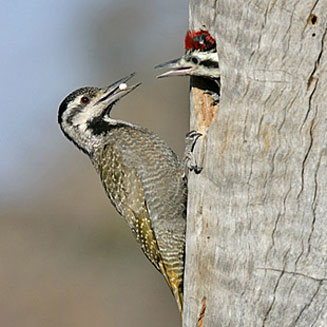|
Dendropicos namaquus (Bearded
woodpecker)
[= Thripias namaquus]
Baardspeg [Afrikaans]; Mbangura (generic term for woodpecker and
also applied to Crested barbet) [Kwangali]; Hohodza (generic name for
woodpecker) [Shona]; Ghongoswana (generic term for woodpecker) [Tsonga];
Kôkômere, Phaphadikôta [Tswana]; baardspecht woodpecker [Dutch]; Pic barbu
[French]; Namaspecht [German]; Pica-pau-de-bigodes [Portuguese]
Life
> Eukaryotes >
Opisthokonta
> Metazoa (animals) >
Bilateria >
Deuterostomia > Chordata >
Craniata > Vertebrata (vertebrates) > Gnathostomata (jawed
vertebrates) > Teleostomi (teleost fish) > Osteichthyes (bony fish) > Class:
Sarcopterygii (lobe-finned
fish) > Stegocephalia (terrestrial
vertebrates) > Tetrapoda
(four-legged vertebrates) > Reptiliomorpha > Amniota >
Reptilia (reptiles) >
Romeriida > Diapsida > Archosauromorpha > Archosauria >
Dinosauria
(dinosaurs) > Saurischia > Theropoda (bipedal predatory dinosaurs) >
Coelurosauria > Maniraptora > Aves
(birds) >
Order: Piciformes
> Family: Picidae
The Bearded woodpecker occurs from central Africa to southern
Africa, absent largely from the DRC. It dislikes dense forest, preferring
deciduous woodland and savanna. It mainly forages in trees, tapping and probing
branches in search of insects, licking them up with its barbed tongue. Both
sexes excavate the nest, which is usually a oval-shaped hole in the trunk of a
tree, although it has been recorded nesting in fence posts. Here It lays 1-3 eggs, which are incubated by both sexes, for roughly
13
days. The chicks are cared for by both parents, leaving the nest at about 27
days old. The juveniles become fully independent roughly 1-2 months after
fledging.
Distribution and habitat
It occurs from the Central African
Republic to Senegal to South Africa, mostly absent from the DRC. In southern
Africa it is fairly common in Mozambique, Zimbabwe, northern Namibia and
north-eastern South Africa. It dislikes dense forest, preferring deciduous
woodland, thornveld, broad-leaved woodland, being most common in miombo (Brachystegia)
and mopane (Colosphermum mopane).
|
 |
|
Distribution of Bearded woodpecker in southern
Africa, based on statistical smoothing of the records from first SA Bird
Atlas Project (©
Animal Demography unit, University of
Cape Town; smoothing by Birgit Erni and Francesca Little). Colours range
from dark blue (most common) through to yellow (least common).
See here for the latest distribution
from the SABAP2. |
Food
It mainly forages in trees, tapping and
probing branches in search of insects, licking them up with its barbed tongue.
The following food items have been recorded in its diet:
- Coleoptera
(beetle larvae and pupae), especially:
- Mopane emperor moth (Imbrasia belina) larvae
-
termite alates
-
spiders
- lizards
Breeding
- Both sexes excavate the nest, which is usually an oval-shaped hole in the
trunk of a tree, although it has been recorded nesting in fence posts.
 |
|
|
Bearded woodpecker at its nest to feed chick,
Nylsvley area, South Africa. [photo Warwick Tarboton ©] |
|
- Egg-laying season is from April-December, peaking from May-August.
- It lays 1-3 eggs, which are incubated by both sexes for roughly 13
days.
- The chicks are cared for by both parents, leaving the nest at about 27
days old. The juveniles become fully independent roughly 1-2 months after
fledging.
Threats
Not threatened.
References
-
Hockey PAR, Dean WRJ and Ryan PG (eds) 2005. Roberts -
Birds of southern Africa, VIIth ed. The Trustees of the John Voelcker
Bird Book Fund, Cape Town.
|
